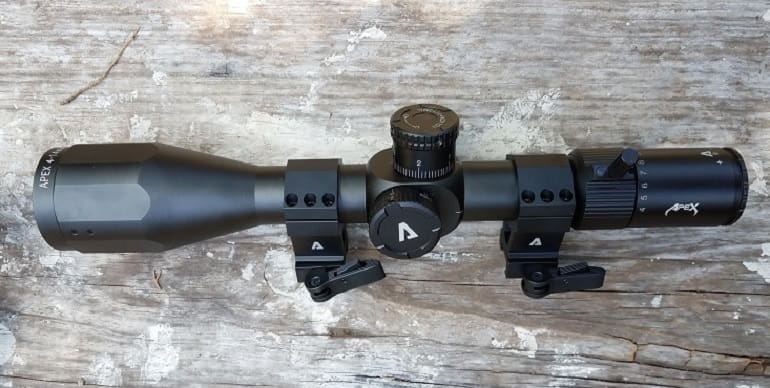
TTAG is slowly ending my scope snobbery. Well, less TTAG itself and a lot more the opportunity to shoot through increasingly better quality budget glass.
A while back I wrote about my go-to-review optic, the Atibal Nomad 3-12×44. That particular scope reviewed extremely well and kept me on the lookout for Atibal’s scopes in the future. The future is now.
Atibal’s new Apex 4-14×44 FFP re-sets the bar for budget quality yet again, improving image clarity while retaining or improving many of the features I liked about the Nomad.
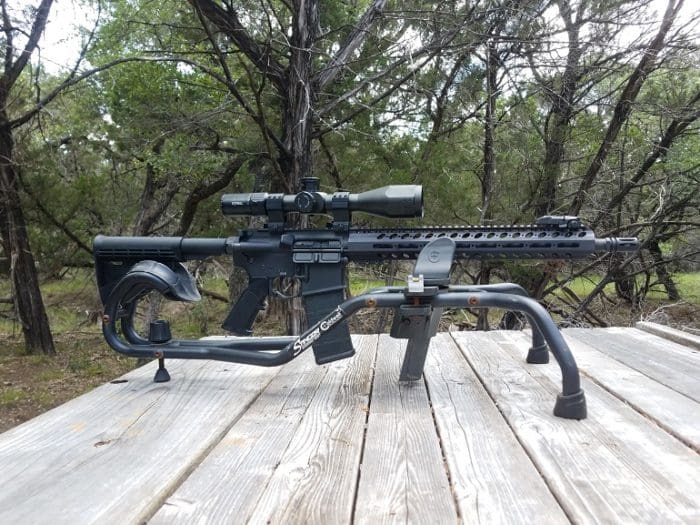
When Jeremy handed me the Apex for review, he commented that the glass quality was even better than the previous model I’ve been using. Whatever. I trust nothing from these hipster millennials.
The glass quality is even better than the previous model I’ve been using.
For folks shooting MOA targets out to 400 yards or so, glass of this quality is all they will ever need. Yes, there may be more clarity that you want, but I can read the difference between 4-inch numbers on trash cans at 400 yards with this scope, even at dusk. I can certainly tell the difference between a white tail buck and a doe.
On a clear, bright day, I find there is not a huge discrepancy between good glass and great glass. (The Apex is very good glass.) The differences are pretty hard to notice until you push the ranges out past 500 yards or so, and also in cloudy days or in failing light.
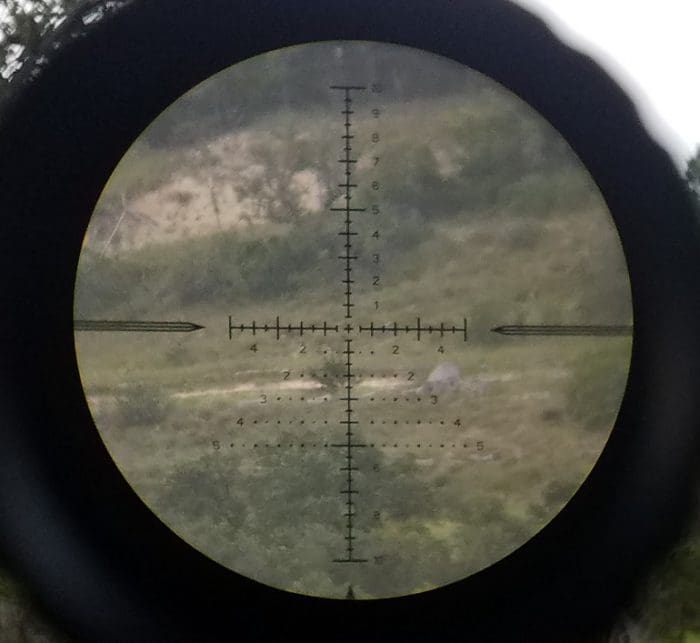
Take a look at the photos above and below. That rock is just a tad bit over 600 yards away. The images were shot within just a couple of minutes of each other on a cloudy day near sunset and facing north.
Both scopes are set to 14X magnification. The scope on the top is the Atibal Apex, the scope below is the Vortex Viper PST.
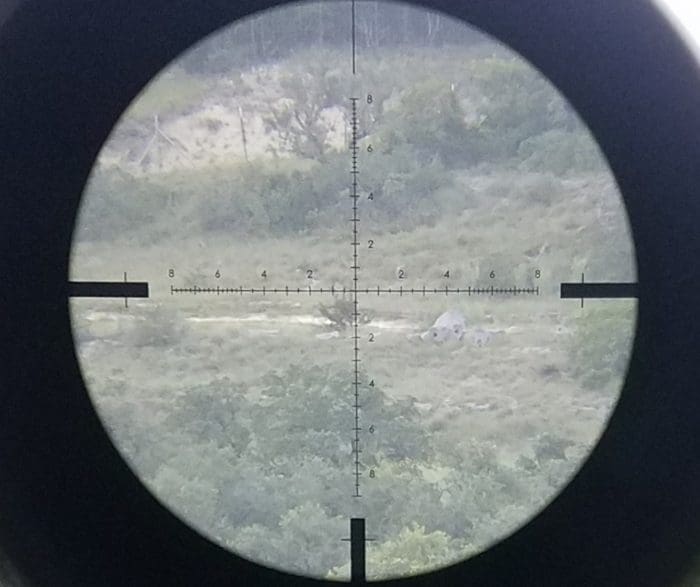
Note the significant difference in brightness on the Viper PST. This is mostly an illusion. In reality, it’s not quite that much brighter. This photo highlights that the Atibal Apex has a tight eye relief, making photos challenging. It’s also more challenging to get your face in exactly the right position quickly.
There is a difference in image quality. You can make out more details on the more expensive (well over double the MSRP) scope. But not much more.
Take a look at the contours on the rock, or the space between the leaves of that Agarita bush to the rock’s left. Those are the places I can see a difference, but you really have to look for them.
Again, the waterproof, fogproof Apex costs half as much as the Viper PST. During a bright day, those differences practically disappear.
Here’s what the Atibal Apex looks like in the middle of the day under the shade of a tree. (Ignore the fuzzy reticle, it’s purely a result of the set-up for this photo.)
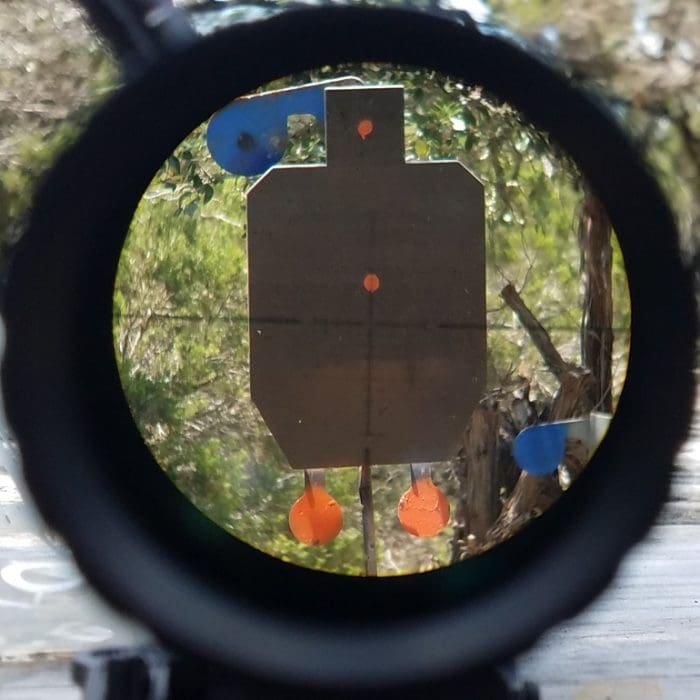
That is great clarity, and really shows off how far budget glass has come. I was happy with the glass on the Atibal Nomad, and the Apex is a noticeable step up from that.
I have a few different rifle scopes under the $500 level. I had to use the Vortex Viper PST line in the comparisons above because that’s the first scope I found that had any better quality than the Apex.
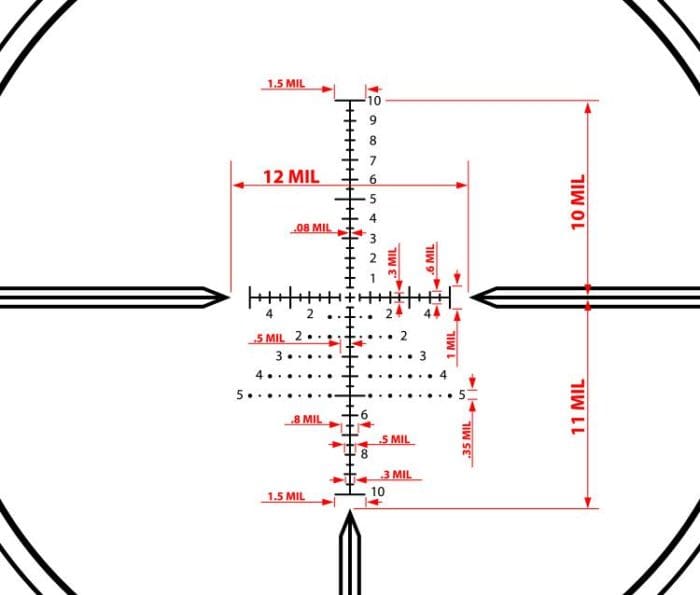
The T&E Apex I received includes a Mil-based reticle. According to the Atibal website a MOA reticle is also available.
This one includes hashes at the half Mil mark for 10 Mils both above and below the center line of the scope, and 5 Mils of windage on each side of the vertical line.
You’ll also note the “Christmas tree” dots below the horizontal. Once you learn to use these dots with your specific load, holding for windage and elevation at the same time is a fast process. As with most things in life, do your homework and everything is a whole lot easier on test day.

The Apex is a first focal plane scope. That simply means the reticle itself is placed forward of the magnification lens. The value of FFP scopes is that the reticle remains the same size in relation to the image as you zoom, allowing you to use the reticle to range at any magnification. Traditional second focal plane scopes only allow for accurate ranging at the highest magnification.
Although that’s the traditional wisdom, it’s not actually true. Ranging on any scope is possible at any magnification, as long as you know the relationship of the reticle/dot to the environment at every magnification possible. That, however, can be confusing and very time-consuming.
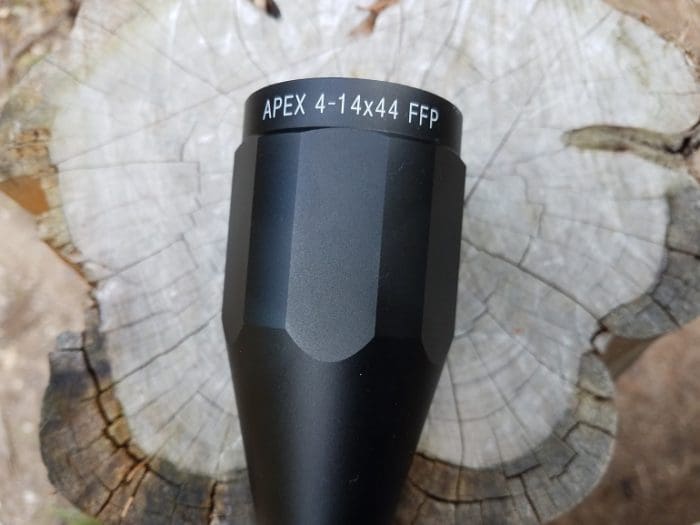
I’ve never cared much for FFP scopes, as I’ve always done my ranging at the highest magnification possible for more precise estimations anyway. However, during the last Hundo in Hondo team endurance shooting match, I definitely saw the weakness in that approach.
If you have multiple targets at different ranges, the ability to dial to a lesser magnification to spot and range them all saves a whole lot of time, and you can still pull in tight to range or hold wind for the farther targets if you have to.
The downside to first focal plane scopes is that it can be hard to maintain reticle sharpness. That makes sense, as any fuzziness in the reticle is magnified as you dial in.
When comparing the Apex to other scopes in its price range, there’s no doubt the reticle is just as sharp as any I’ve found. If I jump up a lot in price I can, maybe, just maybe, tell a difference in the sharpness of the reticle at the 14X magnification with much more expensive scopes. But even then, just maybe. I really have to jump way up about 10X in price to the Schmidt & Bender PM II to see an obvious difference in reticle sharpness.

The turrets are the very welcome “pull to unlock” type. Like the Nomad I’ve previously used, the turrets are well and clearly marked. Unlike the Nomad, the turrets themselves move much more sharply and with a much crisper feel on the Apex.
That said, if you find yourself counting clicks, work on using those well-marked dials as they should be used, and you’ll find yourself making a lot fewer errors, not to mention getting on target a whole lot faster. There’s no marker to let you know how many rotations you’ve gone, but this is very easily fixed at home.

The Apex comes with a quick-throw lever on the magnification dial. If you find that you have to continually change magnifications across the 3.5X zoom range, this is pretty helpful. What’s even more helpful is that Atibal has made this feature a screw on/off post. That’s particularly important, since if the scope is on full magnification, the post is at the far right, putting it right in the way of your bolt handle on a bolt action rifle.
On my ARs, the post worked fine, but on my bolt guns it ensured that I couldn’t work the bolt. Easy enough, I unscrewed it and used the magnification ring normally. It moves easily, but stays in place. I’d likely just leave the post off. Still, options are a good thing.
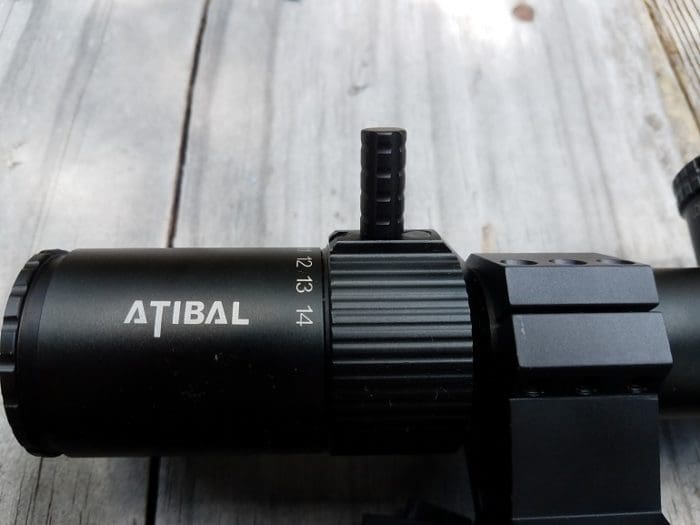
I am a fan of Atibal’s warranty, although I still haven’t had to use it. They call it their “No B.S. Lifetime Warranty.” It’s a short, declarative statement anyone can understand.
If your Atibal product becomes defective, broken, or is no longer working we will get it repaired or replaced. It’s that simple.
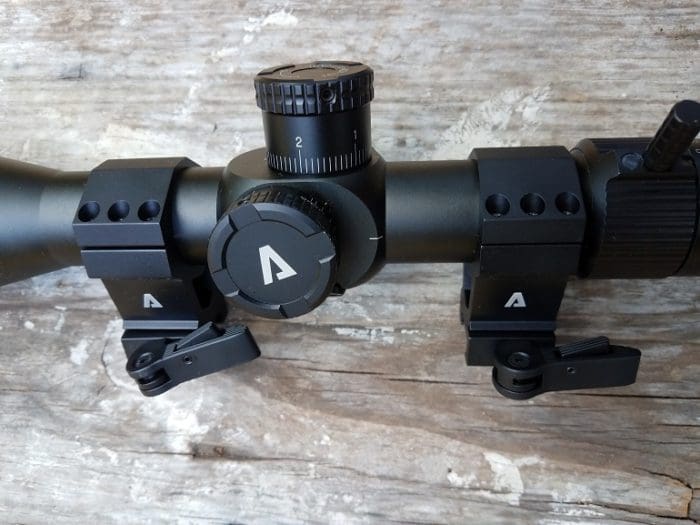
The rings included with the T&E scope are a bit of hybrid. They are traditional two-piece 30mm rings, but each with their own quick-detach lever. To test if they returned to zero, I mounted the scope in the supplied rings on a Colt Competition AR-15 and mounted it in a Caldwell Stinger shooting rest. I then shot targets with IMI’s 55gr FMJ rounds at 100 yards.
I shot 5 shots, then pulled both levers and took the scope off the rifle. I re-mounted it in exactly the same spot (pushing forward hard against the rail) and shot again. I did that three times for a total of 15 shots. All of the shots ended within 1.5″ of each other. I lost probably 1/4 to 1/2 MOA in the re-mounting procedure. That’s the same amount of error I get on my LaRue one-piece mounts I’ve used for a decade.
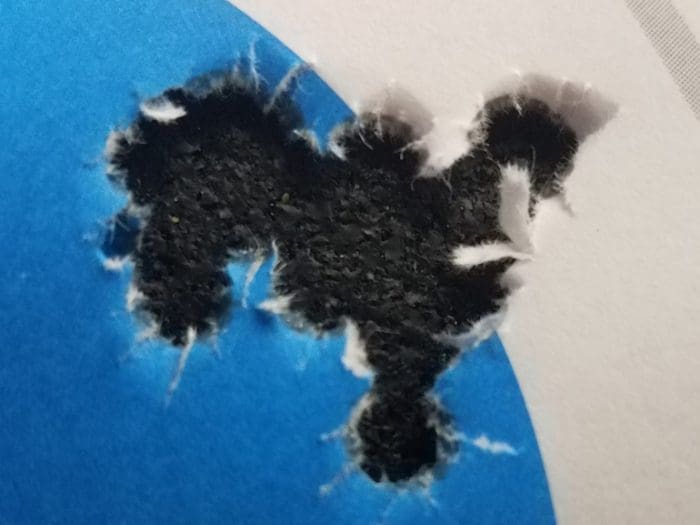
As with all of my scope reviews, I did a simplified box test. I used to bother shooting groups at each corner, but now I just shoot the bottom right corner, dial left, up, right, down, and shoot another round. In this case that was 18″ horizontal travel each way and 30″ vertical (who can tell me what common target I was using?)
I was shooting the Apex on my new 6mm SLR from Kiote Rifles, so at 100 yards I ended up with what was probably two holes in the bottom right corner of the target, but it looked a whole lot like one. In short, the turrets track. Using the same target, it was easy to measure that the reticle was accurate as well.
One of my few disappointments with the Apex is the same as it was with the Nomad — very little movement makes a big change in the parallax adjustment. That makes fine tuning the parallax — much less marking it — very difficult at ranges much beyond 200 yards. I’d like to see more movement required for change.
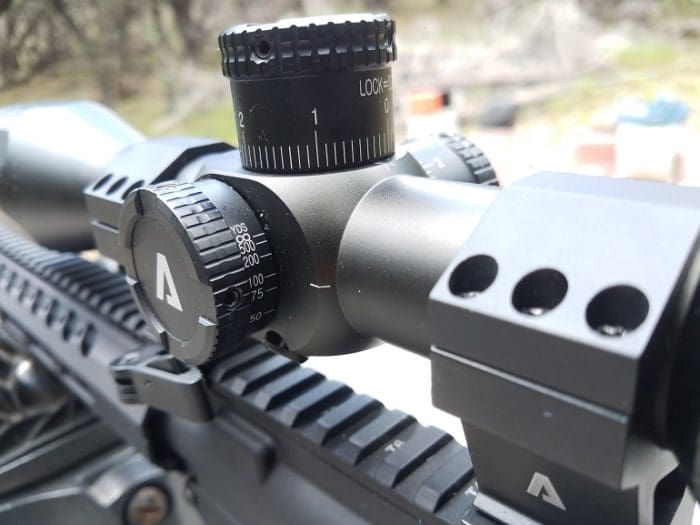
Like the Nomad before it, the Atibal Apex has proven to hit way above its weight class. At less than $500, the Apex packs in the same features several other budget glass manufacturers are putting on their scopes. So what? Features are cheap.
Clarity and light transmission rarely is. This is exactly where the Atibal Apex rises above its competitors. From what I’ve seen, this is the sub $1000 optic to beat.
SPECIFICATIONS: Atibal Apex 4-14×44 FFP Scope
Magnification: 4-14x
Length: 13″
Objective Lens Diameter: 44mm
Eye Relief: 4 inches
Field of View: 26.1-7.8 ft
Tube Size: 30mm
Turret Style: Target Turret
Adjustment Per Click: 1/10 MIL
Horizontal Adjustment Range: 22 MIL
Vertical Adjustment Range: 22 MIL
Weight: 25 ounces
Lenses: Lanthanum glass with multicoated lenses
Body Material: 6061-T6 aircraft grade aluminum
MSRP: $499
Ratings (out of five stars):
Overall * * * * *
My complaints about the scope are quite small, and maybe something I would have taken more into account for a $3000 scope. For a scope I can find easily online for $425, the fact that my major compliant is too little space for parallax adjustment seems silly. This is a feature-packed scope, with glass noticeably better than its competition. I had to jump to double the price before I saw a difference in glass quality. The simple and outstanding “No B.S.” warranty is icing on the cake.





So… Right now I’m looking at spiffy new glass for my SBR and my SPR. I’m thinking 1-8 variable for the SBR and something with a bit more magnification for the SPR. I’ve more or less settled on the 1-8 ATACR for the low power variable, any suggestions for the SPR? (100-600 meter precision work.) It’s a 1/2 MOA gun, so being able to clearly see my targets for longer range shots will be critical to get the most out of it.
If you can still get it at the preorder price, the US Optics TS20X.
2.5-20? DAMN… Ok… I’m seriously reconsidering the 1-8 ATACR… Any suggestions there or is that basically top of the shelf for LPVOs?
I am not usually a Nightforce fan, but I actually really do like that scope. As an alternative, I like these as well https://www.usoptics.com/product/ts-8x/
I’ll try the TS20X and see where I stand once I put that thing through its paces. I have regular monthly PR events where I can see how well this thing does from 10-200 yards. I was REALLY impressed with the magnification range and price point. I didn’t really expect an optic I would want to put on my rifle for under $2k
US Optics “USO” line is Chinese. It has zero to do with anything marked US Optics that’s made in Montana and I have no reason to believe offers anything whatsoever that’s a step up from Atibal or like Primary Arms’ Chinese models or Vortex’s Chinese models, etc. I played with them at NRA and immediately recognized some of the models as coming from the same factory as other Chinese scopes we’re all familiar with but are available at a fraction of the price.
Thanks Jeremy, I didn’t know that. I assumed their 1 to 8 model was the same as the one to six models that I have, which are absolutely outstanding . Apparently that is not the case.
After some additional research, the USO branded US Optics line has primary components made in China, but assembled and QC’d here in the US.
Thanks, I was a bit concerned as in my business, you know better than to trust chicom QC. Components are fine and it makes the gear a whole lot more affordable than their US sourced lines. We’ll see how well the thing shoots and holds zero. With 77gr Razorcore OTMs I should be able to pop plates at 600 meters.
4-14×44 is a nice, well rounded scope size/magnification…
How is it that you still can not disclose that this is PLA manufactured in chicomland? Litmus test – if you’re financing the R&D and manufacturing base of an existential threat to the US and the free world you’re WRONG.
Japan, Philippines even Vietnam. China is huge NO GO for goods that have direct mil counterpart. ANY factory in China producing firearms components is PLA.
Because I don’t care about it at all. If the pla would like to make quality low-cost weapon optics for the United States consumer I’m all for it.
I also buy russian-made ammo every chance I can get. And I don’t believe, for even a second, that Russia or China is an existential threat to the United States of America.
The only real existential threat this nation faces is itself. The free world rises or falls with us.
And if China and Russia want to sell me the cheap, high-quality materials I could use to kill them if some insane circumstance made it necessary, so much the better. The only problem comes if the US lacks the ability to make those things for itself…but then we’re circling back to the part where this country is its own worst enemy again.
If there’s a US product that can do the same job for a similar price, I’ll go US every time. But in my current financial circumstances, it’s cheap or not at all when it comes to firearms and necessary accessories, so…
Maybe I missed it but where is it manufactured? China?
I think so.
I would really like to see some of these blogs review some of the smaller companies that make product for the larger names but do not disclose it. Like Shepherd Scopes and their 1-8x Rugged and BRS models. But Atibal is a good one and no complaints there. Just a small bit of feedback.
I recently came across Shepard scopes for the first time. The rogue series seems like a pretty good deal. But then there is their DRS system scopes (for a whole lot more money).
TTAG did a series on muzzle devices. How about a series on scopes in different price ranges? It is really difficult to compare otherwise similar scopes to find the one most suitable for one’s purpose. Just for example, one can read great reviews and horrible reviews about the Nikon budget scopes–how is one to judge?
I bought my first Leupold scope circa 1982. Never looked back. I tend to be brand loyal. Must have 10+ Leupold scoped rifles and many more have passed through my hands. neiowa, likely many items in your home are made in China. It’s almost impossible not to own something from there today.
For the same $499, u might consider the Primary Arms 3-18/50 FFP silver series. Better yet, how about a comparison test between both scopes.
I’d recommend this as well. Atibal scopes have been… Not unimpressive, but just adequate. Which for a budget scope is praise-worthy. Still, I’m a glass snob and much prefer paying for HD/ED glass in a scope with turret mechanisms that are 100% reliable and accurate. Some serious box testing and tall target testing would be appreciated, JWT. Speaking of, I’d love to read a write up about your time at the 12 Hundo. I had a blast and can’t wait to do it again next year.
“Some serious box testing and tall target testing would be appreciated, JWT. ”
I completely understand and agree. I hate optics review because they take forever.
I’ll get on that write up on the Hundo in Hondo soon. Waiting for future dates/locations to cement up.
All in good time, we will get higher end optics made. For high end optics you need to build a reputation over time, not just with optics itself but with customer service and warranties. Once we have proven ourselves with entry to mid range optics (so far we have done a good job). and earn the the trust of shooters we can roll out higher end glass. With the Apex model, it has shown that we are heading in the right direction. It’s ok to be glass snob because we know one day we have something for you. 🙂
Comments are closed.